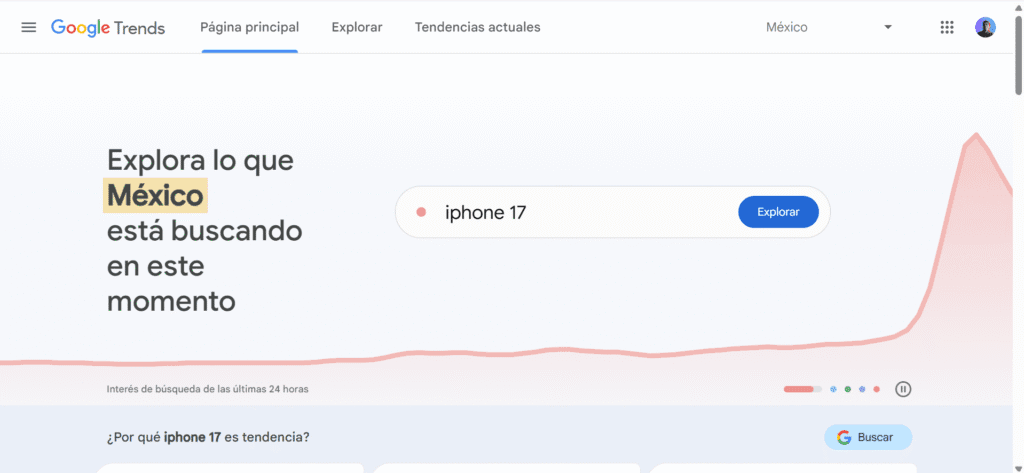Google Trends is a tool free that transforms searches into graphs to show how interest in a word or topic evolves in Google trends, with filters by country and time period that make it easy to compare regional peaks and patterns.. With a scale from 0 to 100, Google Trends shows the relative interest for each search in different time periods and regions. This information helps companies and content creators identify emerging topics and plan strategies. For example, Google Trends reveals the growth of the term "chatGPT" in recent months, helping specialists to create relevant content.
Google Trending: What is Google Trends?
Google Trends is a tool free Google's search engine that displays the popularity of search terms over time. With it, we can find out how many times a word or phrase is searched for in a given period in different regions. This information is presented in graphics where the horizontal axis is time and the vertical axis is the relative level of interest. The data are normalized on a scale from 0 to 100 (100 marks the peak of popularity), which means that Google Trends does not give absolute volumes but the comparative interest between different times. In addition, the platform offers filters by location, time interval, thematic category and type of search (web, images, news, YouTube, etc.), so that we can adjust the analysis to our needs.
Google Trends allows compare several terms in the same query. It also includes sections on "Related topics" and "Related queries"where related or fast-growing words and phrases associated with our term appear. These sections are useful for discovering new content ideas or emerging keywords. In short, Google Trends provides up-to-date data on what users are searching for, helping us to detect patterns, seasonalities and booming topics.
What is Google Trends for?
The main function of Google Trends is to to detect the interest of the public. Among its most important uses are:
- Discover new keywords. By analyzing "Related Queries" you may find emerging terms or variations that incorporate your keyword. This enriches your SEO strategy with alternative keywords that you might not have considered otherwise.
- Plan seasonal content. Google Trends reveals when interest in certain topics increases. For example, the search for "Christmas" spikes every December, while other queries such as "Black Friday" tend to spike in November. With this data you will know in which months it makes more sense to publish articles or campaigns, bringing forward your editorial calendar.
- Analyze the competition. You can compare the interest of your brand, product or keyword with that of competitors. If both have sufficient search volume, they will be seen on the same graph, allowing you to identify who is capturing more attention from the public. It is also useful for measuring the impact of a campaign or event against other players in the industry.
Geographic segmentation: Google Trends provides a map colored by region that indicates where the selected term is most popular. Areas with darker color represent a higher percentage of searches for that term. For example, a chart of Spain may highlight the communities where "digital marketing" or any other topic is most searched for. This information is key to targeting local campaigns or advertising in the places with the highest demand. This way you can target specific regional audiences (local SEO, geolocated ads, etc.).
In addition, Google Trends does not only cover web search engine searches. It allows you to change the data source to Google Images, Google News, Google Shopping and even YouTube. So you can explore trends in different channels and formats according to your target audience.
How to use Google Trends?

To start using Google Trends, follow these practical steps:
1. Open the Google Trends site
To get started, simply open the Google Trends site at trends.google.com. From there you can directly explore the latest trends or search for a specific topic.
2. Enter the keyword or topic
Type the word or phrase you want to research in the search bar and press Enter. You can use broad or specific terms; the key is to start with a seed that you will then expand with related queries displayed by the tool.
3. Apply filters: country, period and category
Adjust the filters to refine the results: select country or region, time interval (day, 90 days, 12 months or custom range) and subject category; also choose the type of search (Web, Images, News, Shopping or YouTube) so that the data reflects the exact behavior you are interested in analyzing.
4. Analyzing the results (graph and heat map)
Watch the main chart for peaks, sustained trends and troughs; interpret relative values (0-100) by shape of the curve rather than by absolute number. Review the heat map to identify regions of greatest interest and use the "Related Topics" and "Related Queries" sections for content ideas and long-tails.
5. Compare terms
Click "+ Compare" to add up to four terms and see them together in the same graph; this comparison helps you decide between synonyms, prioritize keywords and evaluate relative performance against competitors or variations of your theme.
Practical examples
Imagine you run a technology blog and want to measure interest in artificial intelligence tools. If you are looking for "ChatGPT" In Google Trends, you will see a graph that shows pronounced search spikes coinciding with relevant news or updates. In fact, in 2024 Google Trends recorded that "ChatGPT" was one of the most searched topics. This indicates when the public is most attentive to the topic. You could compare "ChatGPT" with "Google Bard" or other AIs by adding both terms in Trends; the resulting graph would show you which one gains more interest at different times. With this data, you would know when to publish articles about AIs (for example, right after a major announcement) to take advantage of the increase in searches.
You can also use Google Trends to plan seasonal content. For example, search for "Christmas" is skyrocketing every December. With this information, it is convenient to prepare Christmas content (gift ideas, decoration, recipes, etc.). several months before of the peak of interest. This way you make sure that your site is already well positioned when users start searching for information on the topic.
Best Google Trends Alternatives
The best overall alternative to Google Trends is Semrush, a SaaS platform for online visibility and content marketing. Other tools that complement its scope are Ahrefs and SimilarWeb, together with Google News (to follow the news in real time), Exploding Topics (detection of emerging trends) and Pinterest Trends (growing visual searches). Together, these solutions provide what Google Trends does not offer directly: estimated search volumes, competitive metrics, web traffic, news context and early alerts on new topics. Each is briefly described below.
Semrush
Semrush comes in handy when you need to go from curiosity about a trend to a marketing strategy with clear priorities. Its keyword exploration shows estimates of volume, difficulty and semantic variations to decide which terms merit content investment or guideline. Where Google Trends offers a relative index, Semrush adds magnitude, competition and business value, helping to calendar publications and measure real opportunities.
Ahrefs
Ahrefs combines keyword research with an in-depth analysis of links and pages that are already ranking. This allows you to see how a trend transforms into organic visibility: you detect content gaps, understand why certain results dominate the SERP and estimate the effort needed to compete. It is a good complement to Trends when you are looking to validate demand and, at the same time, define the SEO tactics to capture it.
Google News
Google News works as a near real-time news radar. It doesn't give you search volumes, but it does tell you what's being talked about today and what stories are gaining traction in the media. Cross-referencing those news peaks with Google Trends helps you anticipate spikes in search interest and react quickly with notes, briefs or updates that capitalize on the conversation of the moment.
Exploding Topics
Exploding Topics looks ahead: it identifies concepts that are starting to grow before they become obvious. It is useful for discovering nascent categories, products or terms and building content or business propositions when competition is still low. Used in conjunction with Google Trends, it allows you to cover both early detection and tracking the interest curve as the topic matures.
Pinterest Trends
Pinterest Trends reflects which ideas and products are gaining attention in a visual environment where intent often approaches inspiration and purchase. It is especially valuable for sectors such as fashion, home, beauty, recipes or DIY, because it shows seasonality, creative peaks and preferences by country or category. When combined with Google Trends you get a picture that integrates general search with visual demand signals.
By joining these tools with Google Trends, you go from "knowing that something is going up" to "understanding how much it's worth, how to compete and when to act": detect signals with Exploding Topics, validate interest with Trends, estimate potential with SEMrush or Ahrefs and fine-tune the creative approach with Pinterest Trends; that chain helps you decide with data what to publish, where and when.
Google Trends in Mexico
Google Trends has local versions (e.g. trends.google.com.mx). In Mexico, the topics of interest may differ: for example, the query "LINEA 3 Trolebús CDMX" or "vacaciones Semana Santa" show their own peaks. The "Trending in your region" allows see what's popular in your area. Google even collaborated with journalists in Mexico to use Trends for election reporting. This demonstrates its value as a public information tool.
Frequently asked questions about Google Search Trends
What is trending?
The term trending literally means "trending" and is used to describe topics, searches or content that are gaining a lot of popularity in a short period of time. For example, in social networks such as Twitter, a Trending Topic is a keyword or hashtag that is mentioned massively at a given time. In general, when we talk about trending we refer to what is most talked about or searched for lately. In Google Trends, a "trending" term is one whose search frequency is increasing significantly compared to the past.
How to do keyword research on Google Trends?
Google Trends offers several features to discover relevant keywords:
- Explore terms: In the Explore tool, enter up to five search queries (you can use the + Compare button to add more terms). This generates a graph of interest over time for each term, allowing you to see which terms have the highest volume or are growing. Adjust location, period and category to segment by country and date.
- Analysis of the graph: See if searches go up or down over time. A steady growth indicates growing interest, while a drop may indicate that the topic is no longer popular.
- Related topics and inquiries: Further down in the page you will find the sections "Related topics" and "Related queries". Change the filter to "Most popular" to view the consolidated keywords, or to "On the rise." to see the queries that have recently grown a lot. This provides insights into new keywords that users are using. For example, in that list terms tagged as "Breakout" are searches with sudden growth (over 5000%), which may indicate emerging opportunities.
What's trending right now?
To find out what is being strongly searched for at the moment you can use the section Current trends of Google Trends. It shows the searches that have most recently increased in popularity. For example, the "Trending Now" window highlights terms with a rapid increase in interest in the last hours, 24 hours or 7 days. Google indicates that on this page you can explore trending searches for more than 100 countries, with data updated every 10 minutes. When you log in, select your country and adjust the time range (e.g., last 4 or 24 hours) and category (e.g., sports, technology). You will then see a list of queries with "active" if they are still growing or "finished" if they are back to normal. In summary, the most direct way to know the current trends is to check these Google Trends listings or their "Trending Searches" page in your region.
How to use Google Trends for SEO?
Google Trends is very useful for improving SEO because it allows you to align your content with what people are searching for. For example, you can:
- Detect emerging keywords: Search for your main term in Explore and check the related inquiries. There you will see which secondary keywords are trending or growing fast. You will see the growth percentage and labels such as "Breakout" (growth >5000%). These clues point you to relevant content ideas.
- Analyze volume trends: The Interest over Time graph shows whether a term is rising or falling in interest. A spike in searches may signal the best time to post or update content; a drop may suggest that the topic is a fad and should be treated with caution.
- Explore related topics: The "Related Topics" and "Related Queries" section (filtered into "Most Popular" or "On the Rise") expands your content strategy. There you will find article ideas or frequently asked questions that your audience is searching for along with your topic.
- Local SEO: In the graph of interest you can choose "Interest by region". This allows you to see if searches for your business or product are growing in specific geographic areas. If you have a local business, filter by your city or country to adjust content and keywords to the right market.
- Benchmark with competitors: Adding your brand name and that of your competitors in Explore shows you how their searches vary. This way you identify where you stand against rivals and which of their terms are also of interest to your audience, which helps you optimize your SEO strategy.
What does "Breakout" mean in Google Trends?
In Google Trends the tag "Breakout" indicates a term for which the search volume has increased dramatically. Technically, it applies to queries with a volume increase of more than 5000% in the period under analysis. In practice, this often happens with words that previously had very low search volume, so Google cannot compare them with numerical accuracy and instead shows "Breakout". For example, a viral news or launch may generate a "Breakout" term. If you see this marker, it means that term is very recent or little known and has just become "trending." These are opportunities to generate fresh content, as long as the topic is relevant to your audience.
Can I compare terms in Google Trends?
Yes, Google Trends allows you to compare up to five terms at a time. To do so, after searching for your first term, click on + Compare and enter another term(s). You will then see overlay graphs showing the relative interest of each term over time. This helps you identify which is more popular in general or in a specific region. For example, you can compare brand names, product names or keyword variants to decide on which to focus your efforts. It is also useful for competitive analysis: by adding the name of your brand and that of your competitors you will be able to see which generates more searches and which related terms are common between them.




